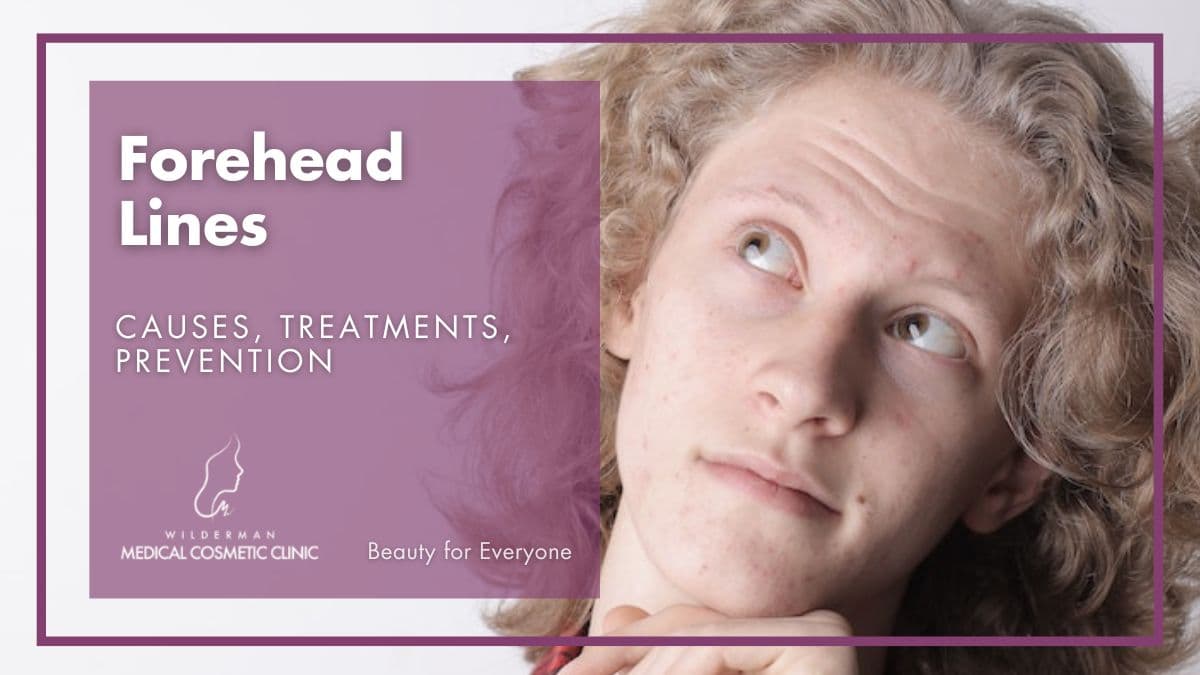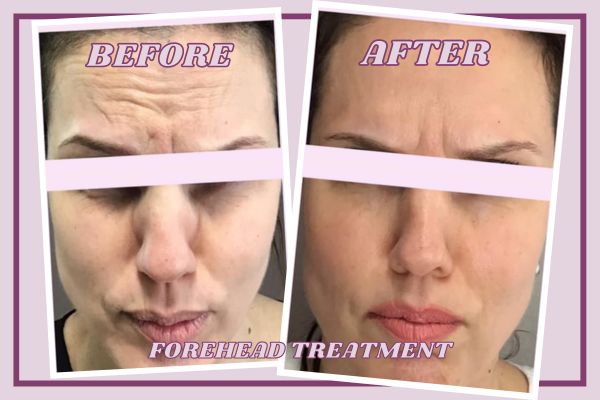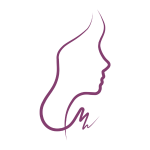Forehead Lines
Causes, Treatments, Prevention
Forehead lines, also known as worry lines or forehead wrinkles, are the horizontal creases that traverse the forehead above the eyebrows.
These lines typically become more noticeable when the brow is raised during facial expressions.
However, with age, forehead wrinkles can become permanent and visible even without any corresponding facial movements.

Get immediate answers about possible treatment options tailored for you, expected results, and much more.
- Expert Diagnosis
- Customized Treatment Plans
- No Obligation
- Comfort and Privacy
- Immediate Answers
Although they pose no harm to one’s well-being, some individuals may wish to reduce their prominence or prevent their development altogether.
What Causes Forehead Lines?
- Aging: As we grow older, collagen and elastin, proteins responsible for maintaining the skin’s strength and elasticity, start to decline. This decrease in collagen and elastin production and the loss of skin elasticity contribute to the formation of lines and wrinkles, including those that appear on the forehead.
- Sun Exposure: Prolonged and unprotected exposure to the sun’s ultraviolet (UV) rays can accelerate the aging process and contribute to the formation of forehead lines. The sun’s rays can damage collagen and elastin fibres in the skin, causing it to lose its elasticity and firmness.
- Genetics: Some individuals may be genetically predisposed to developing forehead lines earlier in life. Factors such as variations in collagen production, skin thickness, and overall skin health can influence the likelihood and timing of their appearance.
- Facial Expressions: Repeated facial movements, such as frowning, squinting, or raising eyebrows, can contribute to the development of forehead lines. Over time, the constant contraction of the underlying muscles creates creases in the skin.
- Smoking: Smoking cigarettes can contribute to premature aging and the formation of wrinkles, including forehead lines. The chemicals in tobacco smoke can damage collagen and elastin fibres, leading to decreased skin elasticity and the early onset of wrinkles.
- Poor Skincare Routine: Neglecting proper skincare, such as not moisturizing regularly or failing to protect the skin from environmental damage, can contribute to the development of forehead lines. A lack of adequate skin care can lead to dryness, loss of elasticity, and the early appearance of wrinkles.
Understanding the causes of forehead lines can help individuals take preventive measures and make informed choices about their skincare routine, lifestyle, and exposure to environmental factors.
What are the Treatments Available for Forehead Lines?

The choice of treatment depends on the severity of the lines, individual preferences, and consultation with a dermatologist or aesthetic professional.
- Topical Treatments: Over-the-counter creams and serums containing ingredients like retinol, peptides, and antioxidants can provide some improvement in the appearance of forehead lines. While the effects may be subtle and temporary, consistent use can help maintain skin hydration, improve texture, and reduce the signs of aging.
- Botulinum toxin (Botox, Dysport, Xeomin) injections: Botox, or botulinum toxin, is a popular and effective treatment for wrinkles, including forehead lines. Botulinum toxin injections temporarily relax the underlying muscles that cause wrinkles, resulting in a smoother forehead appearance. The effects typically last for several months, after which the treatment can be repeated.
- Dermal Fillers (Restylane, Juvedem, Croma, etc.): Hyaluronic acid-based dermal fillers can be used to fill in deeper forehead lines and restore lost volume. By injecting the filler beneath the skin’s surface, it plumps up the area and reduces the prominence of wrinkles. The results are immediate, and the effects can last from several months to over a year, depending on the specific filler used.
- Platelet-Rich Plasma (PRP) Injections: PRP therapy involves extracting a small amount of the patient’s blood, processing it to concentrate the platelets, and injecting the platelet-rich plasma back into the skin. PRP contains growth factors that can stimulate collagen production and improve the appearance of forehead lines. The procedure is minimally invasive and generally well-tolerated.
- Chemical Peels: Chemical peels involve applying a chemical solution to the skin, which causes the outer layers to peel off, revealing smoother, rejuvenated skin. Superficial chemical peels can help improve the appearance of fine lines and wrinkles on the forehead. Deeper peels may be required for more severe wrinkles, and multiple treatments may be necessary to achieve optimal results.
- Laser Resurfacing: Laser resurfacing treatments use laser technology to stimulate collagen production and improve skin texture. Fractional laser resurfacing targets the deeper layers of the skin, promoting collagen remodeling and reducing the appearance of forehead lines. The procedure requires multiple sessions, and downtime and recovery periods may vary depending on the intensity of the treatment.
- Microneedling: Microneedling, also known as collagen induction therapy, involves using tiny needles to create controlled micro-injuries in the skin. This process stimulates collagen production and promotes skin rejuvenation. Microneedling can help reduce the appearance of forehead lines and improve overall skin texture and tone.
- Morpheus8: Morpheus8 is a minimally invasive radiofrequency (RF) microneedling treatment that combines microneedling with fractional RF technology. The procedure targets the deep layers of the skin, stimulating collagen production and promoting tissue remodeling. Morpheus8 can help improve forehead lines, skin texture, and overall skin rejuvenation.
- Dermabrasion: Dermabrasion is an invasive procedure that involves using a rotating instrument to gently abrade or scrape off the outer layers of the skin. This technique effectively resurfaces the skin, reducing the visibility of forehead lines and other facial wrinkles. Dermabrasion requires a recovery period, and multiple sessions may be necessary to achieve optimal results.
- Microdermabrasion: Microdermabrasion, on the other hand, is a minimally invasive procedure that utilizes a handheld device to exfoliate and remove the outer layer of dead skin cells. This treatment helps improve skin texture and appearance, including minimizing the appearance of forehead lines. Multiple sessions are usually recommended to obtain the best possible outcomes.
- Surgical Procedures: In more severe cases, surgical options such as brow lift or forehead lift may be considered. These procedures involve removing excess skin, tightening the underlying muscles, and repositioning the brow to reduce forehead lines and create a more youthful appearance. Surgical procedures typically require a longer recovery period and carry more significant risks compared to non-surgical alternatives.
It’s important to note that the effectiveness and suitability of these treatments can vary depending on individual factors.
How to Prevent Forehead Lines?
Preventing forehead lines requires a combination of skincare practices, lifestyle choices, and protective measures.
- Sun Protection: Protecting your skin from the harmful effects of the sun is crucial. Apply a broad-spectrum sunscreen with a high SPF daily, even on cloudy days. Wear a wide-brimmed hat and sunglasses to shield your forehead and face from direct sun exposure.
- Facial Muscle Relaxation: Be mindful of your facial expressions and try to minimize excessive movements that involve the forehead muscles, such as frowning or raising eyebrows. Over time, repetitive facial movements can contribute to the development of forehead lines. Practice stress reduction techniques, like meditation or yoga, to help relax facial muscles.
- Stay Hydrated: Drink plenty of water to keep your skin well-hydrated from within. Proper hydration supports the skin’s elasticity and helps prevent dryness, which can accentuate the appearance of lines and wrinkles.
- Maintain a Healthy Lifestyle: Adopt a balanced diet rich in antioxidants, vitamins, and minerals. Nutrient-dense foods, such as fruits, vegetables, lean proteins, and whole grains, promote skin health and collagen production. Avoid smoking and excessive alcohol consumption, as these habits can accelerate skin aging.
- Skincare Routine: Establish a consistent skincare routine tailored to your skin type. Cleanse your face gently using mild cleansers, moisturize daily to keep the skin hydrated, and use products with retinoids or other anti-aging ingredients to support collagen production. Exfoliate regularly to remove dead skin cells and promote cell turnover.
- Facial Massage: Regular facial massage can improve blood circulation, stimulate collagen production, and promote relaxation. Use gentle upward strokes on your forehead to help prevent tension and promote smoother skin.
- Sleep on Your Back: Sleeping on your back can reduce the pressure and friction on your face, minimizing the development of sleep lines and creases that can contribute to forehead lines.
- Eye Protection: Wear sunglasses that provide UV protection to shield your eyes and the surrounding skin from sun damage. Squinting due to bright sunlight can contribute to the formation of forehead lines.
By adopting these preventative measures and making them part of your daily routine, you can help maintain a smoother, more youthful forehead appearance and delay the onset of forehead lines.
Conclusion
While forehead lines are a natural part of aging, there are several treatments and preventative measures available to minimize their appearance or delay their onset.
From topical creams to cosmetic procedures, individuals have a range of options to choose from. Combining these treatments with a healthy lifestyle, sun protection, and an effective skincare routine can help maintain a smooth and youthful forehead for years to come.
Remember, embracing one’s unique features and aging gracefully is a beautiful journey in itself.
Reference
Healthline. (Updated on August 14, 2018). How Can I Get Rid of Forehead Wrinkles? Retrieved from https://www.healthline.com/health/beauty-skin-care/forehead-wrinkles#cosmetics (Accessed Jul 12, 2023).
Face Clinic London. (n.d.). How To Reduce And Prevent Forehead Wrinkles. Retrieved from https://facecliniclondon.com/forehead-wrinkles/ (Accessed Jul 12, 2023).
Westlake Dermatology. (Sep 30, 2020). Forehead Lines: Causes, Prevention, And Treatments. Retrieved from https://www.westlakedermatology.com/blog/forehead-lines-treatment-options/ (Accessed Jul 12, 2023).
Insider. (Aug 13, 2021). 7 ways to get rid of and prevent forehead wrinkles, according to dermatologists. Retrieved from https://www.insider.com/guides/beauty/forehead-wrinkles (Accessed Jul 12, 2023).
SKN Clinics. (n.d.). Forehead Lines: Causes, Symptoms and Treatment. Retrieved from https://www.sknclinics.co.uk/conditions/forehead-lines (Accessed Jul 12, 2023).
Other skin conditions that may be of interest
Skin Laxity: A common skin concern – Skin laxity is a common concern that many individuals experience as they age. It is characterized by a loss of firmness, elasticity, and resilience in the skin, leading to a less …
Sagging Skin – As we age, one of the most common concerns we face is sagging skin. The loss of elasticity and firmness can affect various parts of our body, including the face, neck, arms, and abdomen. Sagging skin can be attributed to …
Stretch Marks: Causes, Treatments, Prevention – Stretch marks, also known as striae, are a common skin condition that affects both men and women. They often appear as visible lines on the skin, typically on …
Spider Veins and Broken Capillaries – Spider veins and broken capillaries are common vascular conditions that affect a significant number of people. While they are typically harmless, they can cause cosmetic concerns for …
Oily Skin – Oily skin is a common dermatological condition characterized by excess sebum production, which can lead to a shiny, greasy appearance and potential skin issues such as acne breakouts and clogged pores. While it can be …
Smoker’s lines: A real connection to smoking? – Smoker’s lines, also known as lip lines, lipstick lines, or perioral wrinkles, are fine lines that develop around the mouth and lips. These lines can be unsightly and may contribute to …
Acne Scarring: Causes, Treatment, Prevention – Acne is a common skin condition that affects millions of people worldwide, causing physical and emotional distress. In some cases, acne can leave behind unsightly scars, further impacting …
Dark Under-Eye Circles – Dark under-eye circles can be frustrating and make you appear tired or older than you actually are. They are a common cosmetic concern that affects people of all ages. We will explore what …
Stay Ahead of the Beauty Curve
Beyond Beauty: Elevate Your Routine with Insider Tips and Breakthroughs – Subscribe Now!
Transform your beauty routine into something extraordinary!


